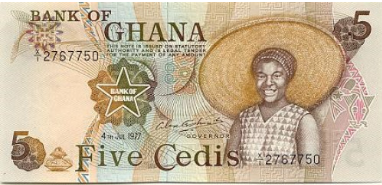Main Article Content
Abstract
This article showed interest in millinery displayed pictorially on the currencies as well as the significance of those fashion representations in Ghana’s fashion culture. The article specifically analysed the millinery fashion that featured on currency notes of 1977 and 1986 and the Yaa Asantewaa’s imagery on the currency note of 1984. Three Ghanaian currencies purposively sampled for the study were the Five Cedis note issued on July 4, 1977; the Fifty Cedis note issued on 15th July 1986; and the Twenty Cedis note issued on 15th May 1984. These currency notes were released within nine years interval, that is, between 1977 and 1986. Content analysis of visual images, and social semiotics methods of visual data analysis constituted the method of analysis for the study focusing on the dominant feminine figures on the currency accessorised with millineries. The study put forward those feminine images represented on the Five Cedis, Fifty Cedis, and Twenty Cedis currency notes issued on July 4, 1977, 15th July 1986, and 15th May 1984 respectively that displayed the repertoire of straw-woven and the Akan militaristic millinery fashion in post-independence Ghana. The millinery practices depicted on the currencies embodied historical allusions to Ghanaian women irrespective of economic background and ingrained in the memory of the citizenry the fashioned feminine identities constructed through millinery fashion in relation to the popular culture of twentieth-century Ghana. The selected indigenous millinery-inspired visuals also celebrated female vitality and brought to the fore the visibility of women in the public sphere and represented the epitome of independent women of twentieth-century Ghana who contributed to national development. It also made a strong socio-political fashion statement about the indigenous classic millinery fashion consciousness of Ghanaians and the millinery structural design in use in the post-independence era.
Keywords
Article Details

This work is licensed under a Creative Commons Attribution 4.0 International License.
References
- Bank of Ghana. (2023). Evolution of currency in Ghana. https://www.bog.gov.gh/bank-notes-coins/evolution-of-currency-in-ghana/ Currency contract signed. (1955, September 20). Daily Graphic, p.20.
- Deutsch, K. (1966). Nationalism and social communication: An inquiry into the foundations of nationality. MIT Press.Gellner, E. (1983). Nations and nationalism. Basil Blackwell.
- Essel, O. Q. (2014). Nkrumaism in sculptural archetypes of Nkrumah. In Arts and Design Studies.17, 45 – 57.
- Fuller, H. (2014). Commemorating an African queen: Ghanaian nationalism, the African diaspora, and the public memory of Nana Yaa Asantewaa, 1952-2009. African Arts, 58 – 71.
- Foreign Exchange Act, 2006 (Act 723). Ghana Publishing Company Limited. İnaç, H. & Ünal, F. (2013). The construction of national identity in modern times: Theoretical perspective. International Journal of Humanities and Social Science, 3(11), 223-32
- Vanini, P. (2008). Visual data. In L. M. Given (Ed.), The Sage Encyclopedia of qualitative research methods (pp.
- -930). Sage Publications Inc.
- Smith, A. D. (1981). Nationalism in the Twentieth Century. In Citizenship and National Identity from Colonization and
- Globalizm, T.K. Oomen (ed.). Sage Publications.
- Skinner, H. & Kubacki, K. (2007). Unraveling the complex relationship between nationhood, national and cultural identity, and place branding. Place Branding and Public Diplomacy, 3 (4), 305-316.
References
Bank of Ghana. (2023). Evolution of currency in Ghana. https://www.bog.gov.gh/bank-notes-coins/evolution-of-currency-in-ghana/ Currency contract signed. (1955, September 20). Daily Graphic, p.20.
Deutsch, K. (1966). Nationalism and social communication: An inquiry into the foundations of nationality. MIT Press.Gellner, E. (1983). Nations and nationalism. Basil Blackwell.
Essel, O. Q. (2014). Nkrumaism in sculptural archetypes of Nkrumah. In Arts and Design Studies.17, 45 – 57.
Fuller, H. (2014). Commemorating an African queen: Ghanaian nationalism, the African diaspora, and the public memory of Nana Yaa Asantewaa, 1952-2009. African Arts, 58 – 71.
Foreign Exchange Act, 2006 (Act 723). Ghana Publishing Company Limited. İnaç, H. & Ünal, F. (2013). The construction of national identity in modern times: Theoretical perspective. International Journal of Humanities and Social Science, 3(11), 223-32
Vanini, P. (2008). Visual data. In L. M. Given (Ed.), The Sage Encyclopedia of qualitative research methods (pp.
-930). Sage Publications Inc.
Smith, A. D. (1981). Nationalism in the Twentieth Century. In Citizenship and National Identity from Colonization and
Globalizm, T.K. Oomen (ed.). Sage Publications.
Skinner, H. & Kubacki, K. (2007). Unraveling the complex relationship between nationhood, national and cultural identity, and place branding. Place Branding and Public Diplomacy, 3 (4), 305-316.





